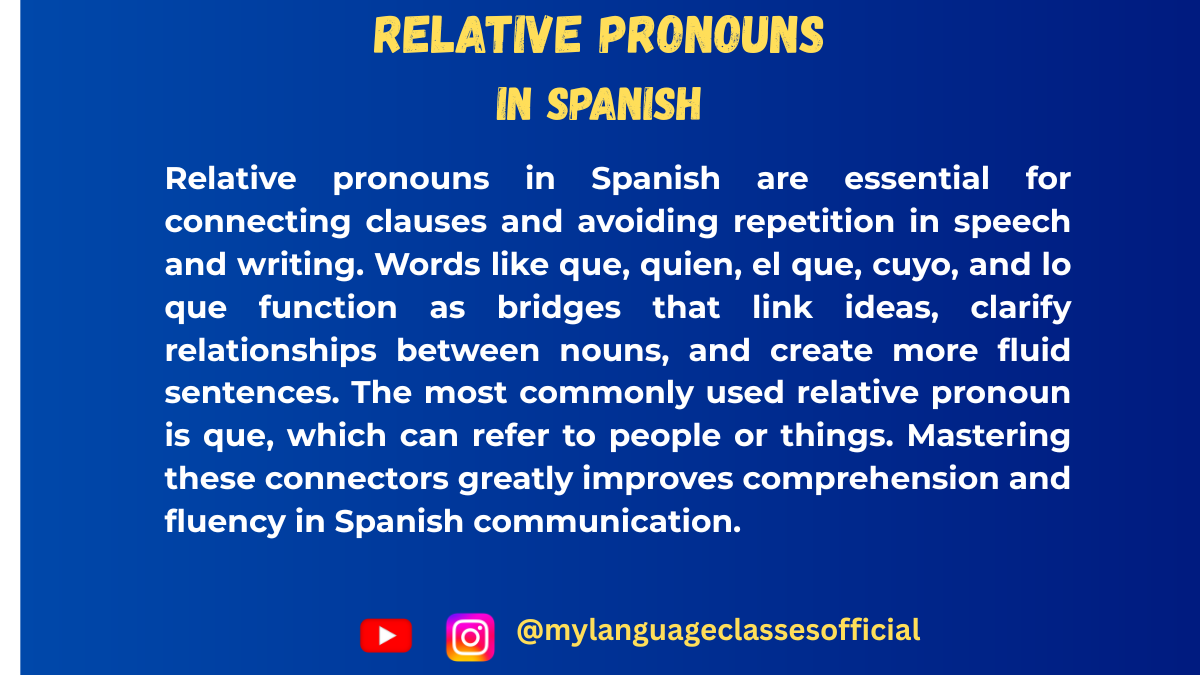Your cart is currently empty!
Relative Pronouns in Spanish

When learning Spanish, relative pronouns are essential for connecting sentences smoothly and making speech more fluid. These pronouns allow us to refer to people, places, or things without unnecessary repetition. In this blog post, we will explore the different relative pronouns in Spanish, their meanings, and how to use them correctly.
List of Relative Pronouns in Spanish
Relative pronouns in Spanish are used to introduce subordinate clauses and refer to a previously mentioned noun (antecedent). Below is a list of the most common relative pronouns, their meanings, and example sentences:
| Relative Pronoun | Meaning | Example Sentence 1 | Example Sentence 2 |
|---|---|---|---|
| Que | That, which, who | La casa que compré es muy grande. | La película que vimos fue interesante. |
| Quien / Quienes | Who, whom | Mi amiga, quien vive en Madrid, me visitó ayer. | Los estudiantes, quienes aprobaron, celebraron. |
| Cuyo / Cuya / Cuyos / Cuyas | Whose | El hombre cuyo coche es rojo está aquí. | La chica cuya madre es doctora es mi amiga. |
| Donde | Where | La ciudad donde nací es hermosa. | Este es el restaurante donde cenamos anoche. |
| El que / La que / Los que / Las que | The one(s) who/that | El libro, el que compraste, es interesante. | Las chicas, las que llegaron tarde, son mis amigas. |
| El cual / La cual / Los cuales / Las cuales | The one(s) who/that (formal) | La casa en la cual crecí está en ruinas. | Los estudiantes, los cuales fueron premiados, estaban felices. |
| Lo que | What, which | No entiendo lo que dijiste. | Lo que más me gusta es viajar. |
| Lo cual | Which (referring to a whole idea) | Perdimos el tren, lo cual fue un problema. | Llegó tarde, lo cual nos molestó mucho. |
| Cuanto / Cuanta / Cuantos / Cuantas | As much/many as | Toma cuanto quieras. | Cuantas veces lo intentó, falló. |
More Example Sentences
- La mujer que trabaja en la tienda es muy amable.
- Mi amigo, quien es muy inteligente, siempre me ayuda.
- El perro cuyo dueño es mi vecino es muy juguetón.
- No entiendo lo que está pasando.
- El país donde nací es hermoso.
- Los estudiantes, los cuales estudian mucho, sacaron buenas notas.
- La casa en la que crecí tiene muchos recuerdos.
- No sé lo que quieres decir.
- Las flores que compraste son muy bonitas.
- La ciudad donde vivo tiene muchas atracciones turísticas.
Things to Keep in Mind
- Agreement in Gender and Number:
- “Cuyo” agrees in gender and number with the noun it modifies: El hombre cuyos hijos estudian aquí…
- “El que, la que, los que, las que” also change according to the noun they refer to.
- Use of Articles:
- “El cual, la cual, los cuales, las cuales” often appear with a preposition and are more formal.
- “Lo que” and “lo cual” refer to entire ideas or situations.
- Que vs. Quien:
- “Que” is used for both people and objects.
- “Quien” is used mainly for people and must match singular or plural (quien/quienes).
- Where to Use Relative Pronouns:
- “Donde” is for places.
- “Lo que” and “lo cual” refer to abstract concepts.
- “Cuyo” means “whose” and agrees with the possessed noun.
Fill in the Blanks
- La chica _______ vive al lado es muy simpática.
- El perro _______ dueño es mi vecino ladra mucho.
- No entiendo _______ dices.
- La ciudad _______ naciste es hermosa.
- Mi amigo, _______ es doctor, trabaja en el hospital.
- Las flores, _______ compraste ayer, están muy bonitas.
- Juan, _______ hermano es mi compañero, me ayudó con la tarea.
- La razón por _______ llegamos tarde fue el tráfico.
- No sabía _______ querías decir.
- El edificio _______ ventanas son grandes es nuevo.
Answers
- que
- cuyo
- lo que
- donde
- quien
- las que
- cuyo
- la cual
- lo que
- cuyas
Conclusion
Mastering relative pronouns in Spanish is essential for improving fluency and making speech more natural. Understanding the gender, number agreement, and context in which each pronoun is used will help you construct sentences more accurately. Keep practicing with different sentence structures, and soon, using these pronouns will become second nature.
If you enjoyed this lesson, be sure to check out more posts like this on my blog at My Language Classes. Don’t forget to subscribe my YouTube channel and follow me on Instagram for the latest language learning tips and lessons. Leave a comment below to share your thoughts, or ask any questions you have.
Happy learning! 😊
📚 Continue Learning Spanish
Comments
7 responses to “Relative Pronouns in Spanish”
-
[…] Relative Pronouns in Spanish | My Language Classes […]
-
[…] Relative Pronouns in Spanish | My Language Classes […]
-
[…] Relative Pronouns in Spanish | My Language Classes […]
-
[…] Relative Pronouns in Spanish | My Language Classes […]
-
[…] Relative Pronouns in Spanish | My Language Classes […]
-
[…] Relative Pronouns in Spanish | My Language Classes […]
-
[…] Relative Pronouns in Spanish | My Language Classes […]

Leave a Reply